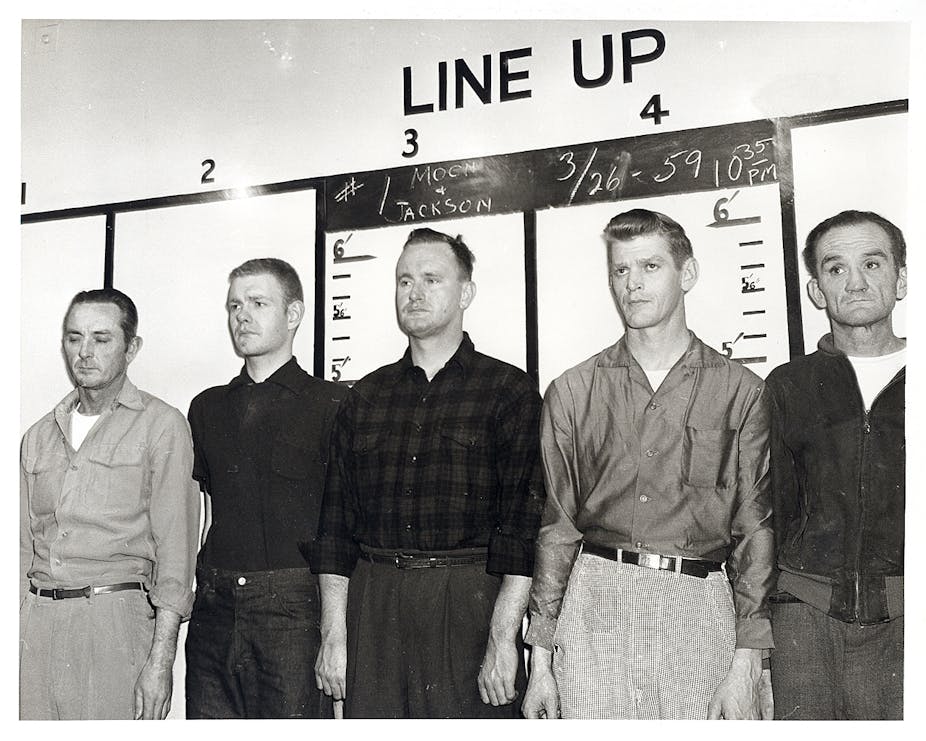Police lineups have long been used in criminal investigations. We have all seen TV shows depicting a witness trying to identify a bad guy from an array of people in a lineup. But in some areas using photos instead is seen as a huge advantage.
It is generally assumed that the “live lineup” provides a more reliable form of identification test than photoarrays (an array of 6-12 head-and-shoulders photos which contains the suspect and a number of fillers or foils).
In South Australia new legislation concerning the conduct of lineups is currently being debated in parliament.
The case for the live lineup
The assumption that a live lineup is superior probably reflects the view that it allows a witness to access a richer array of cues when trying to assess the match between a lineup member and their memory of the culprit.
A witness can examine a lineup member from different angles; get a sense of height, weight, build, posture; detect shadowing around the face, etc. Yet, controlled studies do not provide compelling evidence for the superiority of either the live lineup or the photoarray.
So, which method should we prefer? The photo-lineup offers a number of significant advantages – if done properly!
It is easier to access databases of photographs for constructing a good photo-lineup than it is to assemble people for a live lineup. “Good” lineup construction requires that lineup members match the witness’s description of the culprit and be reasonably similar in appearance. Locating similar looking people who don’t match the witness’s description can produce a biased lineup that is prejudiced against the suspect.
For example, if a witness described a person as male, 35-45 years old, heavily built, piercing blue eyes, and shaved head, it is crucial that all lineup members contain these features that were etched in the witness’s memory when the description was provided. If the lineup contains a group of highly similar-looking people, but only the suspect has blue eyes, then only the suspect is at risk of being chosen.
The advantage of using photos
Given large photo databases, the likelihood of being able to compile a photo-lineup that meets such criteria is much higher than that of assembling an appropriate live lineup.
The availability of databases also allows a photo-lineup to be compiled rapidly, shortening the interval between the crime and the identification test.
It can take a long time to assemble and conduct a live lineup. The longer this interval, the greater the decay of the witness’s memory, and the more likely it is that s(he) will make a mistake.
The photo-lineup offers a number of other advantages. It can be conducted on computer, removing the need to have a lineup administrator present during the test.
Lineup administrators can provide verbal or non-verbal cues – deliberately or inadvertently – to the witness while s(he) is examining the lineup. It is well documented that a lineup administrator who knows the identity of the suspect can shape the witness’s responding at the lineup.
Computerised photo-lineup presentation can ensure that witnesses do not miss the important instruction that the culprit may or may not be in the array, and it allows a precise record of the witness’s response. For example, it can clearly distinguish between a decisive choice of an array member, a “not sure” response, or a “not present” response.
With a live lineup, or a non-computerised photo-lineup, these alternative response options are unlikely to be laid out clearly for the witness – yet their use tells us something important about the witness’s memory and the likelihood that the suspect is the culprit.
Computerised precision
Likewise, computerised recording guarantees the availability of a record of any witness who did not choose the suspect. Such information has important probative value.
Computerised presentation also permits a precise record of how long the witness took to make the identification and their confidence in the identification at the time it was made. Both indices provide important information about the witness’s memory and the likelihood that the suspect is the culprit.
When the match between a lineup member chosen and the witness’s memory of the culprit is good, the identification decision will be rapid and made with very high confidence. While a confident identification decision by no means guarantees its accuracy, slow and unconfident decisions are suggestive of inaccuracy – even if they happen to implicate the suspect!
Furthermore, while witness confidence recorded immediately after the identification response is informative, witness confidence is highly malleable through influences such as interactions with other witnesses, lineup administrators, police investigators, etc. Consequently, courtroom expressions of confidence in an identification can be highly misleading.
Computerised photo-lineups offer a number of important practical advantages, if key principles of identification testing are observed.

